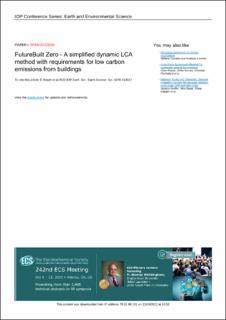| dc.contributor.author | Resch, Eirik | |
| dc.contributor.author | Wiik, Marianne Rose Kjendseth | |
| dc.contributor.author | Tellnes, Lars G. F. | |
| dc.contributor.author | Andresen, Inger | |
| dc.contributor.author | Selvig, Eivind | |
| dc.contributor.author | Stoknes, Stein | |
| dc.date.accessioned | 2022-09-27T08:50:21Z | |
| dc.date.available | 2022-09-27T08:50:21Z | |
| dc.date.created | 2022-09-19T09:33:27Z | |
| dc.date.issued | 2022 | |
| dc.identifier.issn | 1755-1307 | |
| dc.identifier.uri | https://hdl.handle.net/11250/3021658 | |
| dc.description.abstract | FutureBuilt is a voluntary program for ambitious low-carbon construction projects. To incentivize measures that lead to the lowest climate change impact from all aspects of buildings and according to national Paris agreement pledges, FutureBuilt Zero introduces an ambition level and a novel calculation methodology for net climate change impacts over the life of a building. The ambition level is tightened over time to help Norway achieve its climate goals. A comprehensive simplified calculation method is introduced, which considers how the timing of emissions during the building life affects the contribution to global warming. Both direct and indirect emissions throughout the lifetime are included; energy use in operation and at the construction site, material production and transport of materials to the construction site, and waste management (incineration). In addition, the climate-positive effects of biogenic carbon uptake, carbonation of cement, potential for future reusability, and exported energy are included. This paper presents the criteria, describes the method and the scientific basis as well as the principles and logic behind the choices made. | en_US |
| dc.language.iso | eng | en_US |
| dc.publisher | IOP Science | en_US |
| dc.relation.ispartof | SBE-BERLIN-2022 | |
| dc.rights | CC BY 4.0 | * |
| dc.rights.uri | http://creativecommons.org/licenses/by/4.0/ | * |
| dc.subject | LCA | en_US |
| dc.subject | Low carbon | en_US |
| dc.subject | Dynamic factors | en_US |
| dc.subject | Emission intensities | en_US |
| dc.title | FutureBuilt Zero - A simplified dynamic LCA method with requirements for low carbon emissions from buildings | en_US |
| dc.type | Peer reviewed | en_US |
| dc.type | Journal article | en_US |
| dc.description.version | publishedVersion | en_US |
| dc.rights.holder | © 2022 The authors | en_US |
| dc.subject.nsi | VDP::Teknologi: 500 | en_US |
| dc.source.volume | 1078 | en_US |
| dc.source.journal | IOP Conference Series: Earth and Environmental Science (EES) | en_US |
| dc.source.issue | 1 | en_US |
| dc.identifier.doi | 10.1088/1755-1315/1078/1/012047 | |
| dc.identifier.cristin | 2052928 | |
| dc.relation.project | Norges forskningsråd: 257660 | en_US |
| dc.source.articlenumber | 012047 | en_US |
| cristin.ispublished | true | |
| cristin.fulltext | original | |
| cristin.qualitycode | 1 | |

